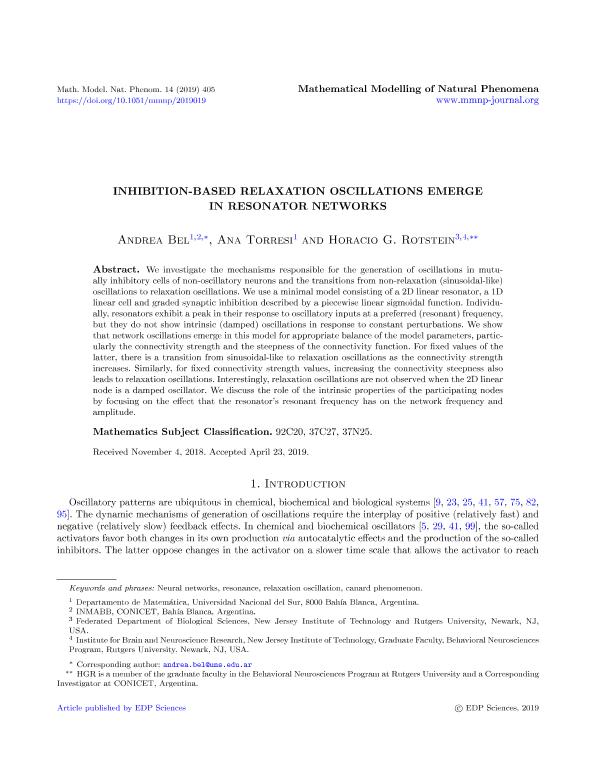Mostrar el registro sencillo del ítem
dc.contributor.author
Bel, Andrea Liliana

dc.contributor.author
Torresi, Ana María Luján

dc.contributor.author
Rotstein, Horacio

dc.date.available
2020-08-20T14:30:17Z
dc.date.issued
2019-05-27
dc.identifier.citation
Bel, Andrea Liliana; Torresi, Ana María Luján; Rotstein, Horacio; Inhibition-based relaxation oscillations emerge in resonator networks; EDP Sciences; Mathematical Modelling of Natural Phenomena; 14; 4; 27-5-2019; 1-28
dc.identifier.issn
0973-5348
dc.identifier.uri
http://hdl.handle.net/11336/112002
dc.description.abstract
We investigate the mechanisms responsible for the generation of oscillations in mutually inhibitory cells of non-oscillatory neurons and the transitions from non-relaxation (sinusoidal-like) oscillations to relaxation oscillations. We use a minimal model consisting of a 2D linear resonator, a 1D linear cell and graded synaptic inhibition described by a piecewise linear sigmoidal function. Individually, resonators exhibit a peak in their response to oscillatory inputs at a preferred (resonant) frequency, but they do not show intrinsic (damped) oscillations in response to constant perturbations. We show that network oscillations emerge in this model for appropriate balance of the model parameters, particularly the connectivity strength and the steepness of the connectivity function. For fixed values of the latter, there is a transition from sinusoidal-like to relaxation oscillations as the connectivity strength increases. Similarly, for fixed connectivity strength values, increasing the connectivity steepness also leads to relaxation oscillations. Interestingly, relaxation oscillations are not observed when the 2D linear node is a damped oscillator. We discuss the role of the intrinsic properties of the participating nodes by focusing on the effect that the resonator’s resonant frequency has on the network frequency and amplitude.
dc.format
application/pdf
dc.language.iso
eng
dc.publisher
EDP Sciences

dc.rights
info:eu-repo/semantics/openAccess
dc.rights.uri
https://creativecommons.org/licenses/by-nc-sa/2.5/ar/
dc.subject
NEURAL NETWORKS
dc.subject
RESONANCE
dc.subject
RELAXATION OSCILLATION
dc.subject
CANARD PHENOMENON
dc.subject.classification
Matemática Aplicada

dc.subject.classification
Matemáticas

dc.subject.classification
CIENCIAS NATURALES Y EXACTAS

dc.title
Inhibition-based relaxation oscillations emerge in resonator networks
dc.type
info:eu-repo/semantics/article
dc.type
info:ar-repo/semantics/artículo
dc.type
info:eu-repo/semantics/publishedVersion
dc.date.updated
2020-05-04T13:29:47Z
dc.identifier.eissn
1760-6101
dc.journal.volume
14
dc.journal.number
4
dc.journal.pagination
1-28
dc.journal.pais
Francia

dc.journal.ciudad
Les Ulis
dc.description.fil
Fil: Bel, Andrea Liliana. Consejo Nacional de Investigaciones Científicas y Técnicas. Centro Científico Tecnológico Conicet - Bahía Blanca. Instituto de Matemática Bahía Blanca. Universidad Nacional del Sur. Departamento de Matemática. Instituto de Matemática Bahía Blanca; Argentina
dc.description.fil
Fil: Torresi, Ana María Luján. Universidad Nacional del Sur. Departamento de Matemática; Argentina
dc.description.fil
Fil: Rotstein, Horacio. Rutgers University; Estados Unidos
dc.journal.title
Mathematical Modelling of Natural Phenomena
dc.relation.alternativeid
info:eu-repo/semantics/altIdentifier/url/https://www.mmnp-journal.org/10.1051/mmnp/2019019
dc.relation.alternativeid
info:eu-repo/semantics/altIdentifier/doi/http://dx.doi.org/10.1051/mmnp/2019019
Archivos asociados
